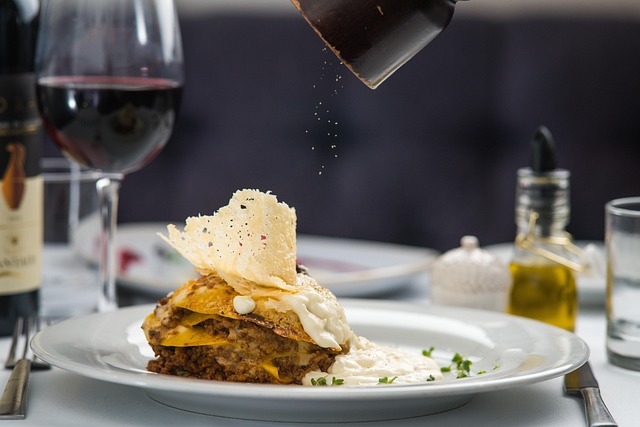Savoring the Symphony: The Art of Food and Wine Pairing
Embark on a sensory journey where flavors dance and aromas intertwine. Food and wine pairing is more than a culinary trend; it's an art form that elevates dining experiences to new heights. From classic combinations to avant-garde pairings, this exploration will ignite your palate and inspire your next gastronomic adventure.

Consider the dominant flavors in your dish. Is it earthy, fruity, or herbaceous? Look for wines that either complement or contrast these notes. For instance, a mushroom risotto pairs beautifully with an earthy Pinot Noir, while a zesty Sauvignon Blanc can provide a refreshing contrast to creamy pasta dishes. The goal is to create a harmonious balance where neither the food nor the wine overpowers the other.
Regional Pairings: A Taste of Terroir
One of the most exciting aspects of food and wine pairing is exploring regional combinations. The concept of terroir – the environmental factors that affect a crop’s phenotype – applies to both wine and local cuisine. Often, wines from a specific region pair exceptionally well with the area’s traditional dishes. This synergy is no coincidence; it’s the result of centuries of culinary evolution.
Take Italy, for example. A classic Tuscan pairing is Chianti with bistecca alla fiorentina. The wine’s high acidity and tannins cut through the richness of the steak, while its earthy notes complement the meat’s flavors. In France’s Burgundy region, the delicate flavors of Pinot Noir perfectly match the local coq au vin. These pairings showcase how local ingredients and winemaking traditions have developed in tandem over time.
Breaking the Rules: Unconventional Pairings
While traditional pairings offer a solid foundation, the world of food and wine is ripe for experimentation. Sommeliers and chefs are increasingly pushing boundaries, creating unexpected combinations that challenge conventional wisdom. These innovative pairings can lead to delightful surprises and new flavor experiences.
Consider pairing a crisp Champagne with buttery popcorn – the bubbles and acidity cut through the richness, while the wine’s toasty notes complement the popcorn’s flavor. Or try a bold Cabernet Sauvignon with dark chocolate – the wine’s tannins interact with the chocolate’s bitterness, creating a complex and indulgent taste experience. These unconventional pairings demonstrate that with a bit of creativity, the possibilities are endless.
The Role of Texture in Pairing
Texture is often overlooked in food and wine pairing, but it plays a crucial role in creating a harmonious experience. The way a wine feels in your mouth – its body, tannins, and effervescence – should complement the textures in your dish. A creamy soup pairs well with a buttery Chardonnay, as both share a smooth, rich mouthfeel. Conversely, a crisp, high-acid wine like Riesling can provide a refreshing contrast to fatty or oily foods.
Consider the textural elements of your dish – is it crunchy, smooth, or gelatinous? A sparkling wine’s bubbles can cut through rich, creamy textures, while a full-bodied red with firm tannins can stand up to the chewy texture of grilled meats. By paying attention to texture, you can create pairings that not only taste great but feel satisfying in your mouth.
Dessert Pairings: Sweet Endings
Dessert pairings offer a delightful finale to any meal, but they require a delicate touch. The general rule is that the wine should be at least as sweet as the dessert, if not sweeter. This prevents the wine from tasting bitter or sour in comparison. A classic pairing is Sauternes with foie gras or blue cheese – the wine’s sweetness balances the richness of the food, while its acidity cuts through the fat.
For chocolate desserts, consider a fortified wine like Port or a late-harvest Zinfandel. These wines have enough body and sweetness to stand up to the intensity of chocolate. Fruit-based desserts pair well with wines that echo their flavors – try a Moscato d’Asti with a peach tart, or a late-harvest Riesling with an apple pie. Remember, the goal is to create a harmonious balance where both the dessert and the wine shine.
Expert Tips for Perfect Pairings
-
Start with what you like: Your personal preferences should always guide your choices.
-
Consider the sauce: Often, it’s the sauce that determines the best wine pairing, not the protein.
-
Balance intensity: Match bold wines with flavorful dishes, and lighter wines with more delicate fare.
-
Experiment with contrasts: Sometimes, opposites attract in food and wine pairings.
-
Don’t forget about temperature: Serve wines at the appropriate temperature to fully appreciate their flavors.
-
Use sparkling wine as a versatile pairing option: Its acidity and bubbles make it adaptable to many dishes.
-
Remember regional pairings: “What grows together, goes together” is often a reliable rule of thumb.
-
Pay attention to cooking methods: Grilled foods often pair well with oaked wines, while raw dishes may prefer unoaked varieties.
In conclusion, the art of food and wine pairing offers endless opportunities for exploration and enjoyment. Whether you’re adhering to classic combinations or venturing into uncharted flavor territories, the key is to approach each pairing with curiosity and an open mind. Let your palate be your guide, and don’t be afraid to break the rules. After all, the most memorable pairings are often the ones that surprise and delight us. So raise your glass, take a bite, and savor the symphony of flavors that await you in the wonderful world of food and wine pairing.





